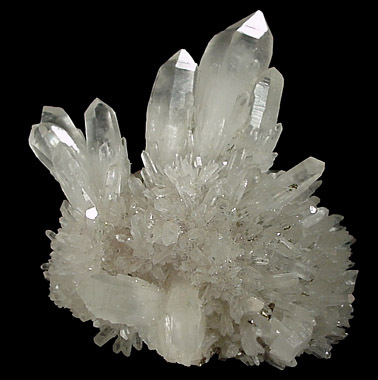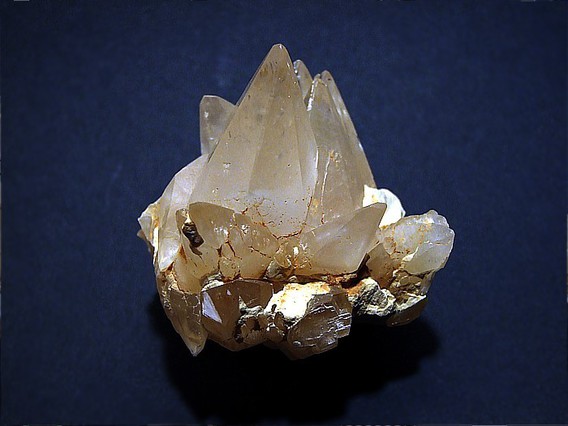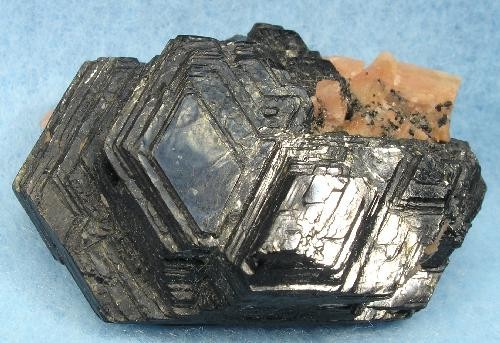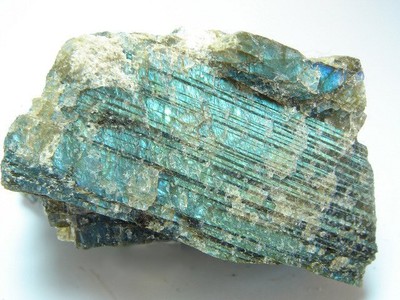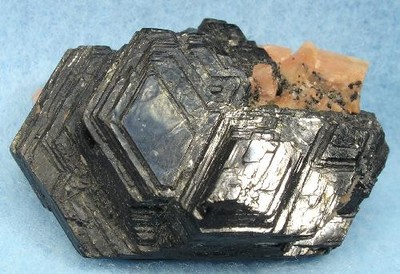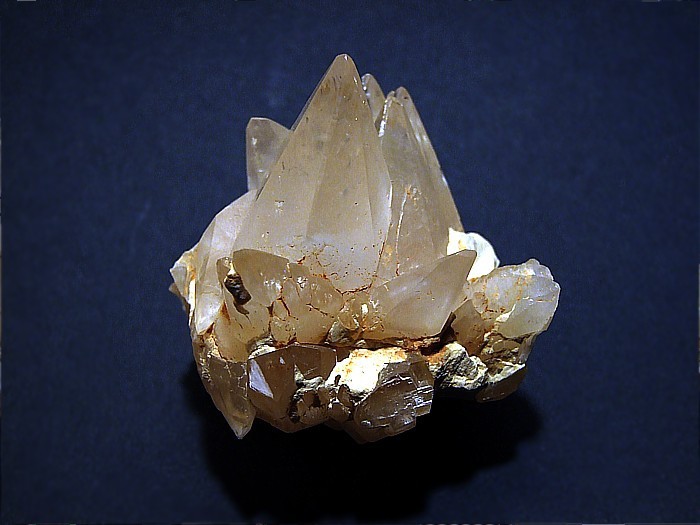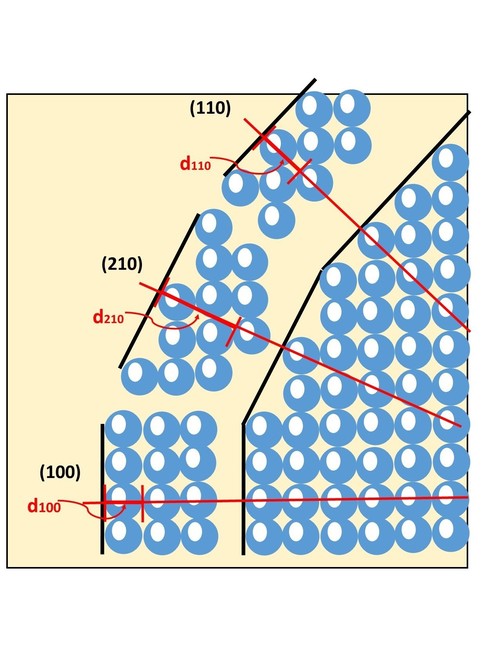What is a mineral?
By Donald Peck (further edits by other mindat.org members)There are several ways to define what a mineral is depending on how formal you want to be.
A completely informal but practical definition:
A mineral is a chemical element or compound that:
1. has a more-or-less constant composition.
2. is usually a solid with an ordered three dimensional array of ions and molecules in its crystal structure.
3. is formed by natural geologic processes and without human or other biologic intervention.
4. is not a mixture of two or more blended substances.
1. has a more-or-less constant composition.
2. is usually a solid with an ordered three dimensional array of ions and molecules in its crystal structure.
3. is formed by natural geologic processes and without human or other biologic intervention.
4. is not a mixture of two or more blended substances.
Four of the Most Common Minerals on the Surface of the Earth
The formal and authoritative definition of a mineral is made by the Commission on New Minerals, Names and Classification CNMNC), a working body of the International Mineralogical Association (IMA). The CNMNC is THE authority on the definition, approval, name, and classification of a mineral, old or new. Both the IMA and CNMNC are comprised of professional mineralogists appointed by the professional mineralogical societies of nations of the world.
Minerals and their names that were reported in the literature and generally accepted by professional scientists before 1959 were accepted by the CNMNC, without review or change. In other words, in 1959, the CNMNC "Grandfathered" all well-accepted and well-described minerals as of that date. From 1959 onward all new minerals had to be approved by the Commission.
In order to clarify procedures and language, in 1995 Ernest H. Nickel, writing for the CNMNC, defined a mineral as:
"In general terms, a mineral is an element or a chemical compound that is normally crystalline and that has been formed as a result of geological processes."
Of course the definition is not that simple. Dr. Nickel went on to explain what the Commission meant by each of the words.
Element or Compound
In his Definition of a Mineral, Dr. Nickel did not expand upon his statement that a mineral is an "element or a chemical compound". To clarify the point the following is drawn from other CNMNC publications.
The mineral may be a single chemical element, such as carbon (C) [diamond or graphite], sulphur (S), gold (Au), or copper (Cu). Natural metal alloys with definite compositions may be approved as minerals [e.g. auricupride (Cu3Au)]. Or it may be a chemical compound that has a more-or-less definite empirical chemical formula that represents its composition. Many NMNMC approved minerals allow substitutions of similar ions in specific crystallographic sites (e.g. Mg2+ for Fe2+, or Al3+ for Ti3+). It is well known that many minerals exist as end members of a continuous series and in most cases are never purely one end or the other of the series. Thus, while the pure end member has a definite composition and chemical formula, specimens within the series, excluding these end members, will exhibit some variability in composition. For example, Forsterite, Mg2SiO4, and Fayalite, Fe2+2SiO4, are the end members of the Olivine Series. In nature nearly all (all?) specimens contain both Mg2+ and Fe2+ and the chemical formula is often written as (Mg,Fe)SiO4 or (Fe,Mg)SiO4 with the dominant ion (greater than 50 atomic percent) listed first and the name assigned accordingly.
A rock is not a mineral, nor is a mineral a rock. However, the components of a rock are minerals. Most types of rock have multiple minerals, a few have only one. For example, by definition, granite is composed of alkali feldspars and quartz. They are the essential minerals to make the rock granite. Basalt is a rock that has plagioclase feldspars and pyroxenes as essential minerals. Either rock may have other minerals but they are not required. Limestone, and quartzite are each composed mostly of a single mineral (calcite and quartz respectively) , but the areal extent of their deposition makes them, by definition, a rock. These essentially single mineral rocks are termed monomineralic rocks; anorthosite (composed mostly of plagioclase) and marble (composed mostly of calcite) are two more examples.
A mineral cannot be a mixture. For example, limonite is a mixture of hydrated iron oxides and hydroxides and is not a single chemical phase (entity). It is mostly intimately mixed goethite, akaganeite, lepidocrocite, and jarosite. Another mixture, wad, is a variable mix of manganese oxides. Mineralogists frequently use names such as 'limonite' as a convenient way of describing the mixture, but with the understanding that it is not itself a specific mineral species.
Crystallinity
Minerals are nearly always crystalline substances. That is, they exhibit a short range, three dimensional, periodicity of their atomic structure. When suitably illuminated by X-rays, or similar wavelengths of radiation, a pattern of spots is generated which can be interpreted as planes identifiable by Miller Indices. The CNMNC requires submission of such data in the approval process for new minerals. The dimensions of the unit cell and axial angles are also required.
There is only one currently-approved mineral that is a liquid at normal temperatures, mercury, which, being a liquid, has no crystal structure and cannot produce a diffraction pattern. Water is not a mineral species, but the solid form (ice) is.
There are, however, a small number of amorphous minerals. Opal is, perhaps, the best known. When the composition is precisely defined through careful analysis, the substance is proven to be unique and a single phase, and when it is shown that a diffraction pattern is impossible, an amorphous substance may be considered by the CNMNC. However this is on a case-by-case basis. Opal, however, is another of these 'historical exceptions' which would never be approved as a mineral under the current rulings, and it is likely in a future 'cleanup' of the mineralogical nomenclature that both opal and mercury will lose their current approved status.
In some rocks, radioactivity has destroyed the crystal structure of one or more minerals. Those substances are said to be metamict. If the metamictization occurred with reasonable certainty due to geologic processes, and it can be shown that the original substance was crystalline and of the same bulk composition, then it can be approved as a mineral.
Anthropogenic substances
Anthropogenic substances are those produced by humans. They are not minerals. Crystals grown in a laboratory (or someone's basement) or in laboratory or industrial furnace or retort are not minerals. Any crystals that are found on or in any man-made object are not a mineral.
Anthropogenic substances Modified by Geologic Processes
In general, the CNMNC does not approve substances as minerals when they are formed by geologic processes operating on anthropogenic substances. The major exception was the "grandfathering" of many of the minerals created by action of sea water on slags at Laurium, Greece, and some crystals found on corroded processed metals, such as abhurite found on tin ingots underwater. Crystalline substances that are formed by natural weathering, solution, and crystallization as a new depositional phase on mine tailings, ore dumps, or slag heaps are seldom approved. However, the CNMNA, occasionally will consider a submission on a case-by-case basis.
Biogenic substances
Nearly all chemical compounds that were formed strictly from biological materials by biological processes are not minerals. If geological processes were involved in the formation of the compound then it may be accepted as a mineral. There are several minerals that result from the action of calcium rich water percolating through bat guano in caves. Many phosphate mineral deposits contain minerals crystallized in large part on the ocean floor from the mobilization of the phosphate ion from fish bone, teeth, etc. The mobilization and precipitation is a geologic process.In both cases crystalline compounds formed naturally and the compounds were/are allowed as minerals. Coal, which has the appearance of a massive mineral, has no crystalline structure and is not a mineral. Rather, it is either a sedimentary or metamorphic rock, in either case of biologic origin.
Extraterrestrial substances
In the past, the definition of a mineral often included the words, "from the earth". With the advent of the exploration of space, and even from the study of meteorites that have landed on our planet, it became apparent that "space materials" and earth materials are much the same. Geological processes on earth and "out there" are also quite similar. Minerals from the moon and planets, asteroids and comets, and meteorites are often identical with those found in the crust of the earth. Some minerals from these sources have been found to be unique. "Geologic process" is now understood to be operative on the moon, Mars, asteroids, comets, meteors and, perhaps, celestial bodies not yet discovered.
So In Sum . . .
A mineral is a chemical element or compound that:
1. has a more-or-less constant composition -- with allowance for substitutions in specific crystallographic sites in continuous series.
2. is usually a solid with an ordered three dimensional array of ions and molecules in its crystal structure. -- A few exceptions are approved for well characterized amorphous substances. The only liquid approved as a mineral is mercury.
3. is formed by natural geologic processes and without human or other biologic intervention. -- Exceptions are made for organic materials that have been changed and crystallized by geologic processes.
4. is not a mixture of two or more blended substances.
And most importantly, has been exhaustively studied and characterized by mineralogists, declared unique in its composition and structure, and the original specimen(s) that was studied deposited for preservation in a professionally curated museum.
Links to the "Determining . . ." Series: How To
What Is a Mineral? The Definition of a Mineral
Determining Color and Streak
Determining Lustre: For Beginning Collectors
Determining the Hardness of a Mineral
Determining the Specific Gravity of a Mineral
Determining Symmetry of Crystals: An Introduction
Determining Fracture and Cleavage in Minerals
References
Nickel, Ernest H. (1995) The Definition of a Mineral. The Canadian Mineralogist, Vol. 33, pp. 689-690 (1995).
Nickel, Ernest H. and Grice, Joel D. (1998) The IMA Commission on New Minerals and Mineral Names: Procedures and Guidelines on Mineral Nomenclature, 1998. The Canadian Mineralogist, Vol 36, pp.3-ff.
De Fourestier, Jeffrey (2002) The Naming of Mineral Species Approved by the Commission on New Minerals and Mineral Names of the International Mineralogical Association: A Brief History. The Canadian Mineralogist, Vol. 40 pp 1721-1735 (2002).
Gaines, Richard V.; Skinner, H. Catherine W.; Foord, Eugene E.; Mason, Brian; Rosenzweig, Abraham; King, Vandall T.: Dana's New Mineralogy. John Wiley & Sons, Inc., New York, 1997. ISBN 0-471-18310-0
Website of the International Mineralogical Association (IMA). http://nrmima.nrm.se/ Commission on New Minerals, Nomenclature and Classification
Acknowledgements
My gratitude is extended to Erin Delventhal, Debbie Woolf, Keith Compton, and Greg Little for reading this article and making several valuable comments that improved the content and flow. I am particularly grateful to Erin Delventhal who helped me through the intricacies of the Mindat Markup Language. . . . DBP
